If you put just any average primer on stained wood, on walls with water stains, or on wood with ‘knots’…and then paint it…the stains will bleed through every of paint and you will have to start over—square one. Stain blocking primers are very important.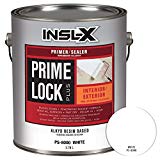
Primers come in various levels of firepower and when you have stains, you need a stain-blocking primer with a lot of power. On a daily basis, my choice to make sure I have sealed off the stain is Prime Lock from Ben Moore. It’s an oil-based interior primer. Others that I use, such as latex primers shellac primers, and some exterior primers are all shown below with what they do for you.
What is the best stain-blocking primer? This depends on your problem. If you had a water leak and you are painting walls or ceilings with stains, you need to block the stain with a primer that contains stain-blockers. These stains will bleed through all paints if not stopped with a stain blocking primer.
Can I use any primer? Not for stains or for wood “knots”. Primers without stain-blocking components merely make different surfaces with un-alike porosity all the same: they do not block tannins and resins. This is oversimplified but true, you do need stain blocking primers.
If you want the shortlist here at the top,
For blocking severe stains use:
 Benjamin Moore’s best blocker: (interior) Prime Lock Plus indoors and Block Out for the exterior—see exterior primers, jump below. I have never had any tree sap, or tannin or any water stain or tree knot stain bleed through this top-notch primer. These stains can take a long time to bleed up into the topcoats which makes us unprofessional. Because PrimeLock is an oil-based primer, have some mineral spirits (paint thinner) handy for clean up, as well as disposable rags. To apply, I like to pour off some into a quart can, and cut the handle of an older brush that I will leave in the can for next time. It’s messy, you’ll need gloves, but why throw away brush after brush? Just a pro tip for you.
Benjamin Moore’s best blocker: (interior) Prime Lock Plus indoors and Block Out for the exterior—see exterior primers, jump below. I have never had any tree sap, or tannin or any water stain or tree knot stain bleed through this top-notch primer. These stains can take a long time to bleed up into the topcoats which makes us unprofessional. Because PrimeLock is an oil-based primer, have some mineral spirits (paint thinner) handy for clean up, as well as disposable rags. To apply, I like to pour off some into a quart can, and cut the handle of an older brush that I will leave in the can for next time. It’s messy, you’ll need gloves, but why throw away brush after brush? Just a pro tip for you.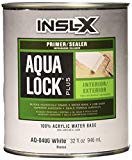 When you don’t want to mess with oil-based blockers, go with Aqua Lock Plus. This is Ben Moore’s best water-based primer and it’s what I use as a primer when the walls or ceiling have some staining issues. After this primer dries, if any of the tough stains come through, I hit them with a spot of the PrimeLock shown above. My time is money. I don’t get ‘call-backs’ for stains that I left behind.
When you don’t want to mess with oil-based blockers, go with Aqua Lock Plus. This is Ben Moore’s best water-based primer and it’s what I use as a primer when the walls or ceiling have some staining issues. After this primer dries, if any of the tough stains come through, I hit them with a spot of the PrimeLock shown above. My time is money. I don’t get ‘call-backs’ for stains that I left behind.- What is the best stain blocking primer? The ultimate nuclear-option, the very best stain blocking primer is BIN, a shellac-based primer with white pigment. That link is for the quart and the image below is for the gallon. It’s very toxic but very effective. Cleans up with rubbing alcohol, and comes in a spray (linked below). It is the #1 stain blocking primer on the market and dries very quickly.
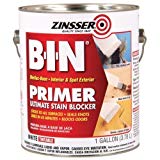 As with the Prime Lock above, I keep a throw-away brush right in the can, because there is no cleaning a brush in any reasonable way when you use BIN. I cannot see using a brush once then throwing it away! BIN needs to be stirred or shaken every few hours. Watch the video below as I make a fool of myself showing how to shake a paint can without taking it to a paint store.
As with the Prime Lock above, I keep a throw-away brush right in the can, because there is no cleaning a brush in any reasonable way when you use BIN. I cannot see using a brush once then throwing it away! BIN needs to be stirred or shaken every few hours. Watch the video below as I make a fool of myself showing how to shake a paint can without taking it to a paint store.
Primers do get very complicated, but below I make it digestible. You’ll be the judge of that!
Prevent a nightmare: get the right one!
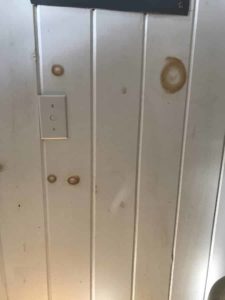
- Primers without blockers: Like with new drywall, different surfaces have different pore densities, and a primer fills and seals them all equally and creates an even surface so your paint will not be shiny here and flatter there. We call this ‘flashing’.
- Stain blockers come in the more expensive primers—these stop resins, tannins and other bad guys like tree sap, that will bleed through into your topcoats of paint.
Do you always need a primer with stain blockers?
No, not unless you see stains or if you are painting never-before-painted-wood.
Sometimes it takes a year for some wood knots to bleed through, so you need to be sure now.
Choosing a Stain-Blocking Primer
You want to block all the stains in one step. You should really never need 2 coats of any primer. (Exterior primers are at the bottom.)
As always, using poorly engineered primers (and paints) is more expensive in the end. Spending more upfront saves money in the long run.
Choice #1: Simply the best
Whether you just have a few stains or even if are you converting wood trim or cabinets to paint: Lightly sand every square inch (just enough to scratch it up for better bonding—we use 150 grit sandpaper—then…
The best and first choice should be an oil-based primer (yes, you can put latex paint over it). For daily use, I use Prime Lock Plus from Benjamin Moore, and I’ve never had a problem with stains coming through. Important: wear a respirator (we simplified the complex world of filters here), and open windows or somehow ventilate the area. This off-gasses fast, so after a few hours, you’re safe to be around it with no respirator.
Prime Lock blocks crayons, smoke damage, odors, and all the other stains already mentioned. (See Ben Moore’s spec sheet).
Converting wood trim or cabinets to paint? Jump to this info.
Choice #2: A great stain-blocking water-based primer
If you don’t like oil-based paints, (and who does?), use Aqua Lock Plus, a water-based primer almost as powerful as Prime Block. This link is for the quart, and the image below is for the gallon. Now, this primer has considerable power, but not like the oil-based primer above. Here is one way to go: prime you surface, taking a mental note of where the stains are (a photo is helpful). After the AquaLock dries, check to see if these stains have come through. This may take overnight or longer.
If there are any stains bleeding through, hit them with either the PrimeLock above, or go nuclear with BIN, a shellac-based primer (this link is for the liquid, the spray is just below). Shellac cleans with rubbing alcohol or denatured alcohol.
The BIN spray can is good for any small extras you did not get the first time, but you have to be careful with overspray: it does not come off!
IMPORTANT: you need a respirator for shellac primers! First, you pick the mask (I use and recommend this), which comes without filters…and this filter kit has a great filter for vapors plus paper overlays to keep the dust out of it. Read about the masks, filters, etc on my respirator post. Note: the mask linked just above is the 6200 medium size mask for average size faces. 6100 is small, and 6300 is large.
Choice #3: Odorless oil-based stain-blocking primer
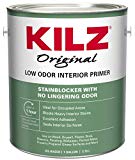 Odorless Kilz oil-based (this link is for the quart, the image is for the gallon), gets you much of the stain blocking ingredients that cannot be mixed in water-based solutions but without the stink. I used this for a very sensitive customer who just bought a smoker’s old condo. But it worked. Popcorn ceiling and all. It’s not totally odorless, but close.
Odorless Kilz oil-based (this link is for the quart, the image is for the gallon), gets you much of the stain blocking ingredients that cannot be mixed in water-based solutions but without the stink. I used this for a very sensitive customer who just bought a smoker’s old condo. But it worked. Popcorn ceiling and all. It’s not totally odorless, but close.
For people with allergies and/or sensitivities, this is a great choice.
Choice #4: Taking a risk with whatever
If you have some random primer leftover from some project, or if you want to avoid the level of toxicity of the big boys above (Aqua Lock is not that bad), go ahead and use your primer. After a short time, you may see some stains bleeding through. Remember that some stains may take a year or more to bleed up through the topcoat.
At that point, just spot prime with BIN (link above) and touch up. NOTHING gets through this primer, period.
Special Problems
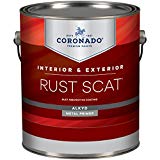 For rust and other metals, seal it with Rust Scat an oil-based, fast drying metal primer. I was surprised how fast it dries on a warm day (outside).
For rust and other metals, seal it with Rust Scat an oil-based, fast drying metal primer. I was surprised how fast it dries on a warm day (outside).
Rust converter from 3M also acts as a primer after changing the rust by chemical reaction. I would still recommend that you prime with Rust Scat (just above) after using it as well before painting.
What happens if you paint over mold?
For mold, first, of course, you need to kill it, using a powerful mold killer (comes in spray bottles too), and then when dry, apply a Mold Killing Primer in any place the mold might grow. Finally, add Paint-Guard a mold-inhibiting additive to your topcoats of paint.
Big Tip: Please don’t use bleach. Bleach does not kill all the spores and the ones that survive multiply faster. Also, bleach is a deadly poison!
Exterior Stain Blocking Primer
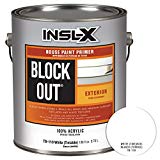 Oil-based primers are preferred by most painters but if you prefer water-based, go with Ben Moore’s Block Out, a latex stain blocker that you can prime your whole house and get great protection and bonding.
Oil-based primers are preferred by most painters but if you prefer water-based, go with Ben Moore’s Block Out, a latex stain blocker that you can prime your whole house and get great protection and bonding.
Oil-based primer and stain blocker is my preference and I use the old standard: Rustoleum’s Cover Stain oil primer when painting outdoors. I’ve gone through a gallon or a thousand.
For the actual work, my advice is to use an old paintbrush for the primer and save the new brushes for the topcoats.
Now, how to do convert wood trim and cabinets to paint…we have it all covered for you, not literally!
- Learn how to convert stained wood (trim, cabinets) to paint.
- What paint you will use? Pros are getting an oil-like appearance with Ben Moore’s Advance and we explain why in this post, and how to apply it in the post on painting over stained trim.
- How to paint trim is a common question, and it’s easier than you think: read the short how-to paint trim.
Spraying primer? Sure. Go for it. We have written all about sprayers here. Graco is the brand that most professional painters trust.
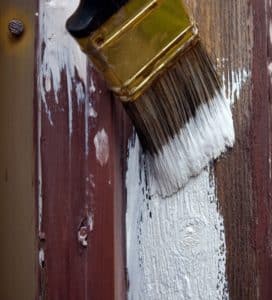 Tip on primers used for spot priming. BIN, in particular, is nasty stuff and as soon as you put a brush in it, that brush will never be useable for anything else. I buy dollar-store brushes for this, even though the bristles fall out! Here is what I do: before dipping the brush, cut off the handle so the brush will fit inside the can with the lid closed. After you’re done priming, seal the brush in the can! Yes, it’s messy when you go to get it out (rubber gloves, man), but you only ruin one brush per can.
Tip on primers used for spot priming. BIN, in particular, is nasty stuff and as soon as you put a brush in it, that brush will never be useable for anything else. I buy dollar-store brushes for this, even though the bristles fall out! Here is what I do: before dipping the brush, cut off the handle so the brush will fit inside the can with the lid closed. After you’re done priming, seal the brush in the can! Yes, it’s messy when you go to get it out (rubber gloves, man), but you only ruin one brush per can.
Paint and Primer in One?
Most painters don’t love them. In the early days, they did not work. But nowadays they have become better at blocking stains. I discussed this in detail in this post on paint and primer. The technology now is that tiny particles come together to form a seal and act as a sealer/primer, but not necessarily a stain blocker. If they fail, we look bad, not the paint makers. Even if the customer does not see it, we do and have to do touch-ups. But it is a faster and less expensive way to go and it’s used in many rental properties.
That’s our look at how to block stains with primer. Have any comments? Let us know below.
Related posts:
- Pick the best paint for your cabinets or trim —-Best Paint for Trim In Every Case
- If you are converting from the wood look to paint, read the essential extra steps you must take to not have a disaster.
- Learn how to paint your trim or cabinets whether you are just repainting or converting from stain. —–Painting Trim (Painting Wood Trim, Cabinets in Any Condition)
Here we just need to seal a stain from a wood knot that bled through the primer and top coats of paint:
How to shake a paint can: always do this for stain blocking primers to mix the solids into the solution.
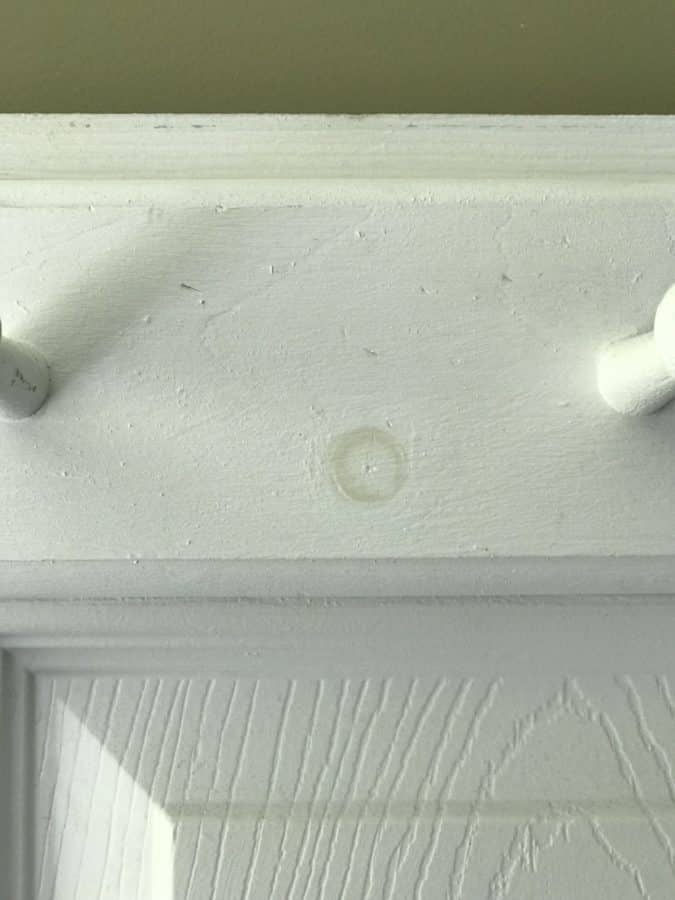
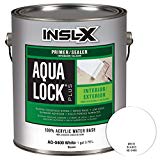
I am refinishing a 100 year old interior door that started finished with shellac, then was painted. Iremoved all the paint by heat and sanded thoroughly, used a Zinnser oil-based stain blood priner and the red bled through. The last time I work on one of my doors, five coats of various primers and top coats left a faint hint of red under the white. No mention anyware of tackling the challenges of shellac. All suggests welcome.
Hi. Those primers are generally pretty good but for what you’re dealing with you need a shellac based primer. That is an alcohol-based shellac that’s rather nasty to work with and it is white pigment it. You would need a throwaway brush and good ventilation. Buy yourself a quart of Kilz or BIN that has an alcohol based white pigmented primer. 1/3 of that, and almost nothing could ever bleed through in 100 years.
Hello,
We are dealing with a handful of pine event tables that like to “leak” sap on really warm days. I have sanded them down to bare wood and plan to use a heat gun, refinish with water based stains and Odie’s Oil. Since we are not planning on painting (but staining) will the stain blocking primer affect the tone of the stained woods? Thanks for any information. I’m new to this but learning each day!
I did not follow. You are not painting, but you are putting a stain blocking primer?…or it’s an old primer? If you sand it all off it should not affect your stain, but the pine is notorious for dripping sap. Not familiar with Odie. I would not use water based stain on pine… you know paint thinner is made from pine so… Oil stain here is my view.
Good luck
b
Hi! Im torn. We have trim and doors stained in Golden Oak. I haven’t noticed any knots, all builder grade stuff. I am not a fan of BIN it’s way too runny and makes a mess! I have used it on furniture projects. Is the Prime Lock have enough stain blocker to keep the stain and tannins from coming through? I have 4200 sq ft of trim and door jams to paint! Thank you!
Very possibly. But BIN and any alcohol-based shellac primer is still better, and sands better too.
Yes, it’s a mess but sands up well.
But no knots and you may be ok. Anyway, watch it over the first few years and if tannin bleeds through, just touch up with Bin, and paint!
That’s a lot of trim, so I might have even made your same choice myself…but I dodn’t like getting called back a year later that knots are bleeding thru!
Good luck
Thanks for your quick reply, Brad! Thanks mostly for “sealing” the deal for me to go with the BIN.
I read that you use the cheaper brushes for the BIN since it’s nasty stuff. Any recommendations on a 4” or 6” roller cover (type, nap) for the BIN as most of my lumber are straight runs and I would like to roll as much as I can.
Thanks again!
I stopped using most small rollers. If I were you, even for just a few sticks of lumber I’d get a 9″ wet with a brush, roll and ‘tip out’. Goes uber-fast.
Rollers can be thrown away in the case of nasties, but that’s sort of bad for the earth.. but dont’ buy crappy roller sleeves… the lint comes right off and you create painted sandpaper…you’ve seen it where all the lint is all over the wall or wood. Ick.
To throw away, I’d still spend 9 bucks on the roller but maybe only 4-5 on a brush…but bristles in those brushes tend to shed.
Sawhorses are going to be helpful too. You can use old paint cans to lift up and let dry. Wrap roller/brush while drying between coats.
Hope it goes well for you!
Hello Brad, hope this finds you well and staying safe!
Thank you so much for the information on your site… your time and professional advise are greatly appreciated!
I have 10 boxes of lumber sitting in my living room for a set of twin loft beds w/ stairs, ladder, shelving, and desk tops for my two toddler boys.
All the wood comes from a bed manufacturer and is measured, cut, and pre-drilled ready for assembly. It is all raw Spruce wood from the Pacific Northwest and arrived sanded and ready for finishing. It’s a soft wood and does have knots and sap streaks.
My wife would like me to paint the set white so I have been researching the best primer and paint to withstand the abuse the bedroom set will endure by my boys 🤪
After calling BM tech reps, paint store associates, and doing lots of reading, I am getting a mixed bag of advise (almost no two have recommended the same primer). Maybe I’m overthinking this, but I just want the best start to preserve/protect this investment for years to come. The bed manufacturer recommended Kilz Premium
BM Advance came highly recommended a few times for my finish coats and I just read your segment on it for trim and cabinets. However, I am curious… what route would you go for primer/sealer and paint if this was going in your house?
Their bedroom is small (hence the need for the loft beds) and the beds are customized to fit wall to wall so I may have to paint some pieces prior to assembly as I will not be able to walk around the perimeter. I’m saying this because I am considering priming individual pieces in my yard to avoid exposing my family as much as possible to harmful fumes.
Hope this information helps you make a recommendation. Sorry for the long post! Appreciate your time to read it and reply if you can 😊
Many thanks,
Frank
You are not overthinking. You’re smart. Do it the inexpensive way and buy the most expensive (best) stain-blocking primer on the market. Those knots will come thru, and if you use a lesser sealer/blocker, it may take a year, but then you get brown spots in your paint. I would use BIN, but not the water-based version. There are two. Use the alcohol based version. Stains will not come thru, but it’s nice to hit all the knots once beofre you do all the wood. If you don’t want that much fumes, which is pretty awful, use the Kilz on the wood, but first seal all the knots with the alcohol. Young boys are going to chip any paint, so keep your top coat in a clean can ready to touch up every few years until they get some sense!
Definitely prime outside if you can, and while there, why not do the first of the two topcoats? It’s quicker. The final coat goes on after you caulk and fill nail holes. Some hole fillers need primer tho, or they ‘flash’.
Good luck. Send photos before and after and I’ll post for others to learn from your experience.
Brad
Zinsser BIN Shellac-Base Primer, 1-Gallon…
Hi Brad, what primer would you recommend for an interior where they burnt wood for 30 years there is black in every wall to ceiling join. And they have a child with disabilities that they can’t move out of the house.
If the disablity involves breathing problems, disregard this: The primer to cover the black soot is Kilz Premium high hide stain blocker. I cannot imagine that it will not cover in one coat even blackened walls. It may, so test this way: pick 2 or 3 spots of different darkness. Apply primer generously, let dry, then put 2 coats of your color over it, and look with a light to see if any black still shows. If so, the darker spots you’ll prime twice.
If breathing problems go with the odor-free Kilz. Not as good, so you may have problems and need 2 coats.
Thanks Brad. Hate these stained mahogany doors and trim but like you said too expensive to replace at around a minimum $100 each. Will use STIX primer and brighten up this old house !!
Hey Brad. Have a few interior 1970’s mahogany hollow core doors with mahogany trim and frames that I want to paint. Would the Aqua-Lock plus work or should I use the Prime Lock plus which, if I understand you correctly, I need to wear a respirator and need to ventilate the house for a few hours.
I know just the doors you mean. Too expensive to replace, but too ugly to keep!
Go with STIX primer. AquaLock is very good, but you want a primer that will bond extremely well. You still need to sand or de-gloss the old finish but don’t take the chance that whatever varnish is on there now will not bond to AquaLock.
I always wear a respirator if I don’t have a cross breeze. Just never know. They told us red M&Ms were safe and that asbestos was safe.
VOCs are low in these products, but get a good respirator. I simplified all that here.
Yes a few hours is the time that VOC is most concentrated but all paint takes weeks or months to cure and will off-gas the whole time. But with ‘low VOC’ paints, don’t worry so much. No need to open windows in the summer. If you in the south, maybe good during the day. In the north, an air exchanger is best.
Good luck!
b
Hi, Brad.
New home building project, here. I have several pine beadboard walls…new, never finished. Unfortunately, our GC did not use the clear pine grade. So, yes, lots of knots. There seems to be too many knots for simply spot priming. Therefore, we’re going to prime all of the beadboard using whichever blocking primer. Considering the beadboard is new, never finished, which blocking primer would you recommend?
Thanks!
Cynthia
I’ll assume this is interior: go with PrimeLock for the entire thing. Best not to spot prime if you have so many, you are correct, but not just for sealing the many knots, but that if you have so many, it’s bound to show up in the final work. If you use 2 liberally applied coats of good paint on top of many spots of primer, maybe not. But you want an even look with no ‘flashing’.
My guess is that the contractor probably tried to save you money by going low-grade, but it seems you’ll be doing work to make up for the savings!
Update: thinking this over, you need a wood primer on all of it anyway as it is untreated. Pine always requires oil primer for best adhesion, so Prime Lock is the thing.
Good luck.
b
You are correct that this is interior. (I apologize for the lack of clarity. I hadn’t yet had my morning coffee!) No doubt our GC was attempting to cut costs, and yes, this has led to more work on the back end. Always the way.
Thank you ever so much for your thoughtful response. That is exactly the information I am needing. Most of my research references blocking knot bleed with old knotty pine, not newly installed, unfinished pine. So, you have been most helpful.
Thank you for your dedication and willingness to help all the wandering souls such as myself!
Kind Regards,
Cynthia
Another point is to do a test area in some lower corner or behind a radiator. Then put some of your color over it and made sure it’s what you want. Testing first is always important with unknowns.
Thanks for the nice words!
Got it and will do! And, you are most welcome.
Best Wishes
🙂
I didnt see where you mentioned block out insl-x for interior? Does it cover water damage and knots?
For interiors it is the same basic stuff, but called Prime Lock plus.
Block Out is designed for exteriors: don’t use inside. The PrimeLock has the same power, but does not dry flexible like exteriors. And is less toxic.
Good luck,
b
Hi there,
I have knotty pine tongue and groove over my fireplace. Thinking I wanted to whitewash stain it, I was advised at a store to buy: Old Master’s oil-based Wood Conditioner, oil-based Pickling White stain and Polyurthane. Husband sanded the raw wood, which after over 30 years was kind of orangey. I applied the wood conditioner and it turned the wood quite dark, kind of mahoghany dark. I applied the picking white stain and it rubbed 95% off no matter how lightly I wiped. I applied and applied and wiped it mostly all off until I was sick of trying. It looked awful if I didn’t wipe. I found applying with a rag better than with a brush (recommended on Old Master’s can.) I have not applied polyurthane. I found pictures online of knotty pine painted with half latex paint/half water that lets the knots show through and looks good to me. Question: if I don’t mind the knots showing, and I am using the same color of latex paint as the stain (white), do I have to sand or prime the wood because the stain on it is oil-based? Thank you so much. Kathy
Hi. Yes after 30 years, what was clear or tinted varnish darkens quite a bit. I would have tried a test spot on some similar wood to see how dark the new stuff would make it.
You are smart to hold off on the topcoat clear as removing that is far harder than the way it is now.
As to your question, always do a test sample. Find some knotty pine, treat it as you did the fireplace and do some testing. The bottom line is whatever you are happy with is what is good.
|Since what you have is oil-based stain, I’m not sure the latex is going to bond. But what will bond is a quality oil-based primer, then any latex coatings you like.
The knots might not come through, but would still be seen as round imperfections, but not the difference in color: that would all be made the same by the primer.
Also, take some photos, go back to that store and get your money back. If they say no, let me know and we’ll put our hundreds of social friends on the case!
made a mistake clearly.
If you can send me photos, I’ll post here for others’ benefit. Read my post on converting stained trim to paint: that will help you understand the bonding issues.
Good luck, and let me know!
b
How long does the Prime Lock Plus need to dry before we can paint over it?
Hi. I recall about 1-2 hrs
Great, thanks!
Thank you so much for your response! It might be a month or two yet bc we are tearing out a wall first, but I will send pics! Thanks!
I am painting over a knotty pine tongue and groove ceiling. It is stained a medium yellow and has a thin coat of varnish on top. Do I need to do any surface prep for a ceiling? Or can I just put on a coat of primer followed by two coats of paint? I was thinking I was going to have to use BIN, but now I am wondering if you think the Prime Lock would be enough? Also, should I wait until winter, when the wood is shrunk b back a bit, before painting? Thanks!
Hi. Interesting question. Since the ceiling will never be touched, I think you are lucky that you don’t have to sand it for touch reasons, but it would not hurt for long-term bonding. If you have a ‘pole sander’ scuff it up with some 100 grit or about that…not so important what grit. Then, since the knots are probably sealed, I don’t think you need a real strong stain blocker. I’d likely end up using STIX for the bonding factor since you won’t be needing much de-glossing. But Stix will not block knots if they want to bleed thru. But the varnish should be your stain blocker. My approach would be to buy a small can of Stix, apply to knots, dry, then ceiling paint on your test spots (1 or 2 coats, whatever you will do for real) and wait a while to see if the knot bleeds through. Sometimes knots show in the primer, but are in fact sealed and won’t bleed up anymore. If they do, go Prime Lock. Good luck! Send me pics and I’ll post before and after if you like: it will really help future readers. Most of all, have fun… sure brad.
–B